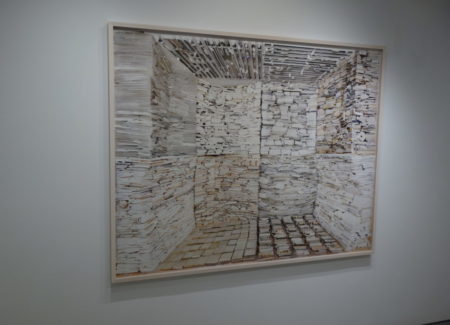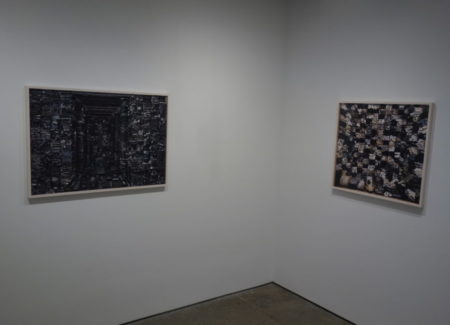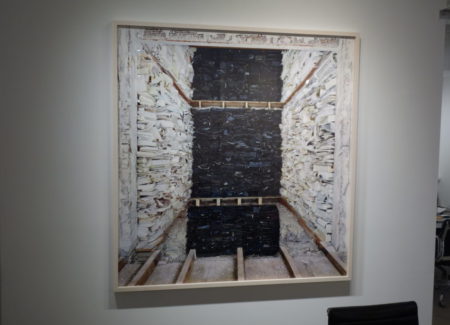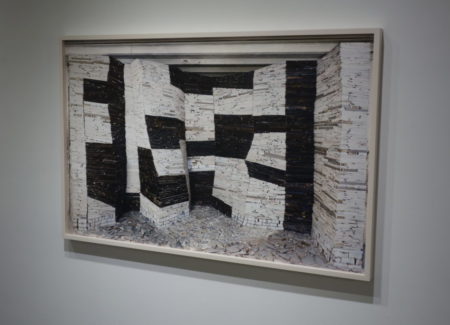JTF (just the facts): A total of 11 color photographs, variously framed and hung against white walls in the front gallery space and throughout the office area. All of the works are archival pigment prints, made between 2007 and 2017. Physical sizes range from 16×27 to 59×74 inches, and all of the prints are available in editions of 5+1AP. (Installation shots below.)
A monograph of this body of work was published in 2017 by Valiz (here).
Comments/Context: The Dutch artist Marjan Teeuwen is a specialist in architectural intervention. Taking her cues from Gordon Matta-Clark and others who have sliced and diced abandoned buildings, Teeuwen uses the underlying framework of a building as the guiding structure for her elaborate sculptural installations, where scavenged plywood, drywall, and broken concrete become the raw materials for her expansive artistic thinking.
In many ways, the artists and photographers who stage physical interventions (either in buildings or in nature) are an extension of a larger group who construct table top or studio set-ups that are intentionally made to be photographed. While the scale and approach to the construction effort changes, the intention is largely similar – to arrange objects in three-dimensional space in ways that will allow photographs of those installations to explore ephemeral markings, patterns, illusions, and engaging optical effects. We can jump from Robert Smithson, to Andy Goldsworthy, to John Pfahl, and back to Matta-Clark and Teeuwen, and although the places and methods might change dramatically, the fundamental spatial issues being explored still share plenty of commonalities.
In Teeuwen’s case, the story begins with an abandoned house, most likely slated for demolition in the relatively near future. In her earliest works, she confined herself to constructed installations within a single room, but the works on view in this show find her expanding her interventions to take over multiple floors or a series of interconnected spaces. But because her process is a zero-sum game (meaning she’s not adding anything new to the installation that wasn’t already there to begin with), she has to destroy before she can rebuild, the transformation becoming something akin to a massive re-formation, where pieces are removed, sorted, organized, and then replaced, the old order and internal logic replaced by something new.
In locations as varied as Russia and South Africa, and then back to the Netherlands, Teeuwen has constructed increasingly complex arrangements. Several of her setups play with bold contrasts of black and white, where installations are either all white or all black, or pieces are arranged into blocks and cubbyholes of alternating colors to create checkerboards or interlocked geometric forms. A close-up look reveals that the materials and textures are extremely heterogeneous, from sheetrock slabs and wall studs piled like layered geological sediments to clusters of rubber tubing, ceiling light strips, cracked tile, foundation rock, plastic piping, broken bricks, perforated mesh, and even electronics. Spatial depth is introduced when walls and floors close in or arcs and squares are cut through boundaries and floors, creating step-wise telescoping and progression effects. In each installation, the chaos of destruction is replaced by the rigor of order, with every single loose fragment placed with surprisingly exacting precision.
More recently, Teeuwen has traveled to Gaza, using an entire two-story building that was already bombed out as the setting for her interventions. As a result, the formula is slightly different – she’s using the entire hollowed interior space for sculptural construction, and she has been able to extend her patterns to the exterior for the first time. The interior views of “Destroyed House Gaza” are filled with textural concrete, with the central floor removed, allowing the gridded space to resolve into squares atop squares, with pillars of rubble as intermediate interrupters. From the outside, the stacked blocks are decorated with different arrangements of rubble, from smooth interlocked walls of brickwork to rough jumbled layers of debris. And while Teeuwen’s previous works feel resolutely conceptual in their thinking, the Gaza house introduces a strong political context, where war and destruction devastate houses daily and residents live within places not unlike Teeuwen’s elaborate funhouse.
While architecture is, in a sense, always sculpture, Teeuwen’s installations accent that idea, bringing a guerrilla mind-set to the balance between construction and destruction. Her interventions combine brash roughness and formal clarity in harmonious ways, the tension of the process making her most intriguing creations feel like transformational magic. She’s thoughtfully embraced the discarded and the decaying, finding venues for inspired improvisation within the fallen stacks of sheetrock.
Collector’s POV: The prints in this show are priced between €7500 and €19500, based on size and the place in the edition. Teeuwen’s work has little secondary market history, so gallery retail remains the best option for those collectors interested in following up.















